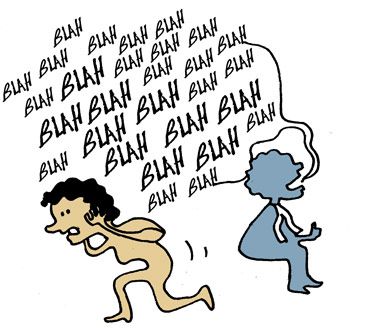Just because you are talking does not mean you are communicating.
Think about that sentence for a minute.
It's perhaps something to do with the way we are taught at our schools. We are taught to read, write, pronounce and spell -- but we are never taught how to listen.
The unsaid message seems to be -- if you make yourself heard, you are communicating! How wrong that can be!
Whether it is in close personal relationships, in organisational contexts or in any of our human interactions -- the implication of this untaught lesson can be very costly.
In our profession of facilitation, learning to "communicate" is clearly a core skill.
A facilitator needs to listen closely to both what is being said and what is unsaid -- something that often reflects through body language and other non-verbal cues.
Having absorbed that, the facilitator needs to choose both his words and his actions in a way that all participants are led through the discussions and the activities in the most natural, non-threatening and facilitative way possible. This is often easier said than done.
From my experience of being a one, here are a few things that I would call your attention to -- that could make you a more effective communicator.
Illustration: Dominic Xavier
Please click NEXT to continue reading...
1. If you are not listening, you will miss the bus
The above line is actually a quote taken from an interview with Naina Lal Kidwai, one of the foremost business leaders in the country.
Most of the time when someone is talking to you, do you actually listen -- and try to understand what the other person's point of view is?
Chances are you are already thinking how to respond. You are perhaps having a conversation with yourself.
Even when you are listening, are you listening objectively -- or are you looking for points to support the point of view that you already hold?
The words of Stephen R Covey give us a good guidance on this subject: "Seek first to understand, Then to be understood".
For us as facilitators, what this means is to listen keenly to conversations that bubble up -- and then react or respond appropriately to it.
It also means not going in with a pre-decided and fixed script which we will deliver, no matter what.
Illustration: Uttam Ghosh
2. Watch out for what is unsaid
There is an astounding statistic around human communication that states that 78 per cent of all communication is non-verbal. Digest that.
What this means is that even without saying a word, we could be saying a lot.
The American poet, Ralph Waldo Emerson, said it so poetically: "Who you are speaks so loudly, I can't hear what you are saying".
There is a reason why people in certain professions dress up the way they do.
Would you believe a doctor who comes to operate you in Bermudas?
The same lesson applies to each one of us too when we are communicating.
What does your dress tell about you? That you are clean and particular or that you are sloppy?
What does the way you stand, the way you walk or the way you greet people tell about you? That you are confident, cheerful and keen -- or that you are diffident, shy and unsure about yourself?
I guess you get the idea -- being conscious about how we project ourselves when we communicate often makes a huge difference in how effective we are as communicators.
Illustration: Uttam Ghosh
3. Watch out for noise and distraction
Communicating effectively is difficult as it is.
Any kind of noise and distraction, only make it even tougher.
Distraction can be of many types -- the environment being too cold, too hot, too sunny or too noisy.
Having mosquitoes or flies around can also be a distraction.
Intrusive cell phones that can ring anytime can be a major distraction too.
In any communication, it is better to pre-empt these distractions. It is always good to state it, if there is something, which is annoying enough and disturbs concentration.
The risk if we do not do this is that the communication can be distorted or misunderstood.
A message misunderstood is worse than a message not sent at all.
Illustration: Dominic Xavier
4. Watch out for your own accent, tone and speed of talking
Like it or not -- all of us carry an accent in our speech.
Of course, Americans think Asians have an accent and Asians think American and Europeans have one.
Apparently, there is no right and wrong, we all have our way of expressing the global language, 'English'.
And most of the times our tone is influenced by the either the local dialect or our family language.
When I came to Singapore this is the first challenge I faced.
At the same time I used to feel that Singaporeans carry a unique accent as well. Some call it Singlish, now the question was whether I should try to adapt to the local accent or whether I should do something about the way I speak to be understood.
Being a facilitator, being understood well was a necessity.
A Singaporean colleague showed me the way. He advised me to slow down my speed of speaking. Luckily for me, this small and timely tip worked really well for me.
Being conscious of the accent that we uniquely carry and our own speed of speaking -- can help us adapt to the communication situation.
In NLP, this is also called "mirroring". We like people who look like us and speak like us.
So, in a communication with someone who speaks slowly, consciously reducing the speed of our speech -- makes us come across as much better communicators. The vice versa is also true.
Another common source of communication problems is the tone we communicate in.
"Why are you so angry?"
"No I am not -- I am just trying to make a point"
"But you can say the same thing politely too, without raising your voice"
The problem in most communication exchanges is that they are all open to interpretation. And while we "say" something -- our body language and our tone -- may be saying something else.
The only way out of this is for a communicator to be more aware of himself.
Learning to communicate better is a lifelong endeavour.
However, the first step towards that goal is becoming aware of the possible pitfalls -- some of which are as stated above.
What are the challenges you are aware of in YOUR communication?
Illustration: Dominic Xavier






Comment
article